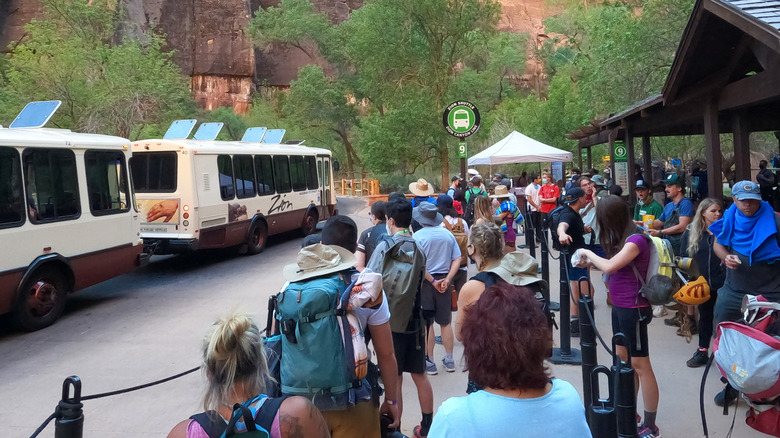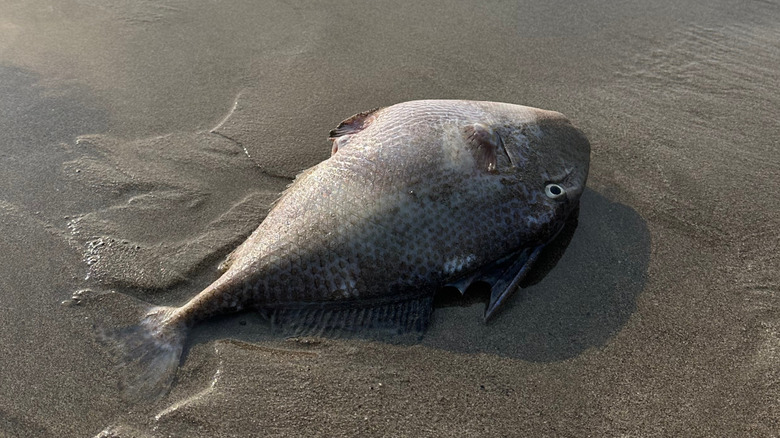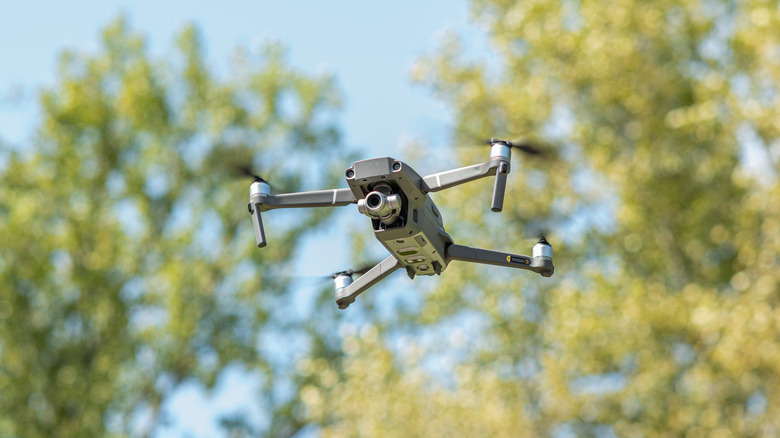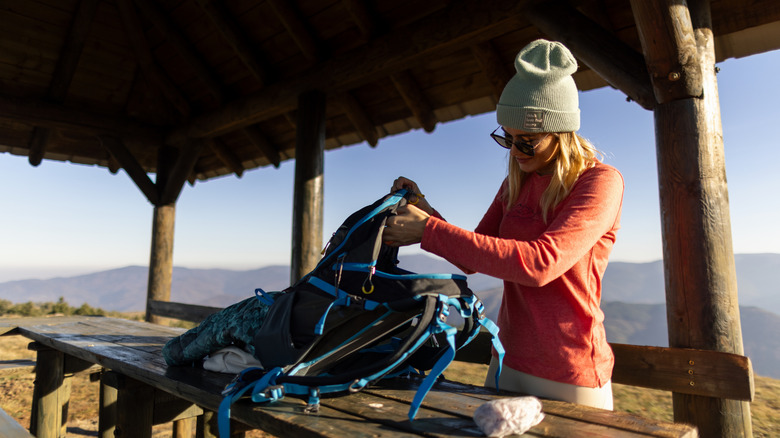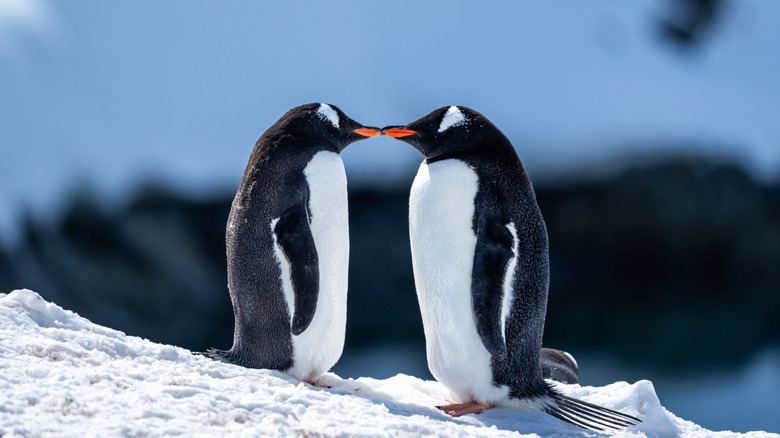Unexpected Things You Might Not Realize Are Banned In National Parks
The national park experience is one of extreme peace and tranquility. Visitors to America's 63 designated national parks (and 433 total park sites) can expect to encounter some of the most vivid and awe-inspiring views on the continent. You'll find the world's longest cave system, the oldest national park in the world, and discover many interesting facts you might not have known about America's national parks.
Perhaps your bucket list includes a trip to a handful of the most visited sites, like the Great Smoky Mountains or Zion National Park, or a quiet getaway to tackle some of the most underrated hiking trails. The experience at Dry Tortugas National Park, near the Florida Keys, might be a starkly different affair than that of Glacier National Park, up in chilly Montana. However, both feature a similar framework for how the National Park Service (NPS) manages its landscapes.
While you can explore America's park system to your heart's content, always keep in mind the NPS' strict regulations for visitors. These encompass prohibitions regarding behaviors within park grounds. Some parks add location-specific rules to the mix. However, for the most part, visitors can enter any national park with a comprehensive understanding of what can and cannot be involved in their day if they've spent some time learning about banned items and activities. These are some of the quirkier entries on the list of prohibited items in America's national parks.
Balloons (of any type) in Joshua Tree National Park, specifically
Helium-filled balloons are not allowed in national parks across the United States. Most commonly seen as a staple of exciting timestamps, if you're considering celebrating an event in a national park, you'll need to leave this decorative addition at home. These balloons are banned because they are all too likely to end up as trash, polluting federally protected lands. Specifically, the National Park Service is concerned about the health and well-being of marine animals in these habitats. Plastic debris has long been a contaminant that creates a significant impact on fish, turtles, and other aquatic animals.
If you are visiting Joshua Tree National Park, note that additional restrictions are in place. The national park has a blanket ban on all types of inflated balloons. This means that you can't bring uninflated balloons to blow later, water balloons, or any other variant into the park. The ecosystem here features a delicate balance, much like every other national park in the country. Park rangers at Joshua Tree take their stewardship tasks seriously, and therefore, the prohibition to encompass even more balloon types than the standard is in place as a safety measure.
Swearing or making obscene gestures
According to Business Insider Africa, the average American lets loose a consistent tirade of curse words, amounting to as many as 90 per day. A casual "damn" under your breath when you stub your toe or get caught at a red light is generally harmless behavior. However, swearing is so prevalent that a 2024 Preply survey found that nearly 40% of Americans felt comfortable cursing in front of their boss (and 48% in front of children). Though far from graceful, it is a human component of language (there have even been studies done on the widespread and global value of the F-word in human linguistics and interactions!).
However, surprisingly, swearing in a national park is prohibited. More broadly, disorderly and obscene speech, behavior, or gestures are banned. Cursing and physical obscenities, like sticking up your middle finger at someone, fall under this category and are therefore disallowed. In practice, you are unlikely to find yourself in any real hot water by swearing in a national park, but this edict against language is a quirky, fun fact worth knowing. It's also something to keep in mind if you're spending a lot of time near park rangers who could call you up on it if they wanted to.
Touching dead fish
You can fish in many areas of America's national parks. Looking into permits and other regulations, like using a single line or avoiding certain types of bait, is important to stay in the good graces of the National Park Service and the rangers who manage the facility. There are also seasonality and sizing regulations governing interaction with certain species, and some aquatic wildlife enjoy year-round protected status. This means you'll have to throw back certain fish if you catch them.
Beyond these rules, fish in a certain condition must always be avoided. Visitors to national parks are prohibited from touching dead fish or interacting with them in any way; the same stipulation covers other wildlife, too. A cluster of dead animals can indicate disease or some other large problem, so it's best to alert rangers to your find rather than doing something about it yourself. Most anglers will already be disinclined to collect dead fish they might run across. However, those who are less familiar with fishing culture might see no difference between catching the fish and scooping a dead one out of the water.
Dead fish can quickly be a source of rot, so you may be introducing pathogens into your immune system by engaging with these animals. Beyond protecting your health, it's illegal to disturb wildlife in a variety of ways while in a national park. This extends to dead animals and their remnants, including teeth, horns, and other body parts.
Flying drones or other UAVs
Drones and other Unmanned Aerial Vehicles (UAVs) have been prohibited in national parks since 2014. For specific filming purposes that the National Park Service has preapproved, the use of these exploratory devices may be acceptable under tightly controlled circumstances. But for the average user, there is simply no leeway in launching a drone and flying it around national park landscapes.
UVAs can be immensely disruptive to wildlife. Even small drones make a considerable amount of noise, and their visual presence can unnerve animals in their natural habitat. Once again, this prohibition falls under the broad aegis of the National Park Service's mission to preserve the sanctity of these natural habitats. A drone can deliver unmatched access to all kinds of scenes, but the negative impact on these protected habitats is just too significant.
Even skilled drone pilots can disrupt the flight paths of birds, spook deer and other ground animals, or even fly into objects and physically alter a part of the habitat directly. With that being said, most drone operators aren't professional users. The potential to cause harm expands significantly as a result of this typical lack of experience and precision.
Building a new cairn and disrupting an existing one
A rock cairn is an ancient navigational tool. These small stone structures have been used countless times throughout history to mark important features. Norse explorers built cairns along seashores. They've been used to identify trailheads and safe passageways through the wilderness. Cairns have also often stood as markers for food caches and other supplies. Cultures across the world have utilized markers like this throughout much of history, and they remain an important tool that park rangers rely on, as well.
It may be tempting to build a cairn of your own after seeing plenty of them used to mark the outline of a hiking trail. Admittedly, the simplicity of their design and the historical weight of their use make them a unique and significant human addition to the landscape in which they inhabit. Building one to perhaps snap a photo or as a means to leave behind your mark on a trail you've conquered might seem like a great idea. However, their importance to the landscape is precisely why building new cairns or interacting with existing ones is prohibited in national parks.
The park service uses them sparingly, but when you encounter a cairn, you can be sure that it marks an important route or resource that hikers and other visitors to the park need to know about. Building a new cairn somewhere in the park can confuse visitors and even create dire circumstances in the most extreme of cases. The same can be said for altering an existing structure.
Taking souvenirs home with you (other than things you might buy in gift shops)
Many people visiting destinations all around the world will frequently seek to bring home souvenirs of their adventures. There are a number of great souvenir ideas that travelers can use to effectively commemorate their time away from home. Sometimes, this involves taking something from the place you've rather than buying an item from a tourist shop. A small vial of sand from the beach you spent the weekend sunbathing on can be a nice, free souvenir to bring home with you.
With that being said, if you're visiting a national park, this type of object removal is strictly prohibited. You can't take anything home with you from a national park other than what you might buy in the gift shop at the visitor center. The environment in which you spend time is carefully monitored to help balance the habitat for plant and animal life in the region. One flower or stone isn't likely to change this much, but the problem lies in the precedent. If one person is permitted to take a jar of sand home with them, countless others might remove this natural resource, as well. Beyond the damage you may inadvertently cause to the ecosystem, it's also rumored that taking away natural souvenirs from a national park can bring bad luck to the culprit.
You can't disturb animals while they're nesting or breeding
Engaging with wildlife directly or disturbing them in any way is against the law on a broad scale. Visitors often enter national parks looking to see wildlife in their natural habitats. Catching sight of bison, dear, or even the occasional bear is an exciting addition to your time in these environments. But seeing these animals and interacting with them are two completely different things. Disturbing animals can be done in a wide spectrum of ways. Yelling at an animal to get their attention, for instance, creates a nuisance that can spook them even without you physically approaching or touching them.
Beyond the typical disturbance and harassing language, it's also illegal to tease animals while they're nesting or breeding. Considering that a beaver, deer, or owl can't understand you, it might seem silly to specifically prohibit "teasing," but the reality is that anything you do to engage with an animal and disturb it can induce unexpected or odd behavior. Animals may panic and end up harming themselves because of your interaction. No matter how you frame the language in your mind, it remains against the law to interact with wildlife in basically any format, especially as they go about their biological business.
Confetti and other similar items go against the parks' 'leave no trace' objectives
The National Park Service is a major proponent of the leave-no-trace concept. This means you should take home everything you bring to a park when leaving (or dispose of it responsibly inside the park if possible). Human beings have a unique understanding of the consequences of their actions. Rabbits, alligators, and eagles know their environments well but might not understand causality as we do. Humans know that leaving a plastic wrapper on the ground impacts the environment, perhaps even for decades. When you leave something behind, it is subjected to the whims of nature. A bird might pick it up and use it to create a nest, or a fish or turtle might eat it, potentially causing death. Ignoring these crucial sustainability rules can ruin your experience while camping or hiking.
It's easy to police wrappers and plastic bottles. All you have to do is put the object back in your pocket or bag after you finish using it. But certain debris poses a much larger challenge. Confetti, in particular, has been targeted by Great Smoky Mountain National Park. It can be an important mood-setting tool when celebrating a birthday or some other special event. However, the nature of this decorative item makes it incredibly difficult to clean up, even in a contained space with no wind or other dispersal factors. Confetti and other difficult-to-manage objects should not be brought into national parks because they will almost certainly enter the environment and stay there.
Marijuana remains illegal at the federal level, so it's prohibited in national parks
Marijuana is something of a quirky addition to this list. It is a banned substance in national parks, so leaving it at home will always be your best bet. However, smokers might not realize this legal instruction that pertains to national park lands for one crucial reason. Only 4 U.S. states have left marijuana products completely illegal at the state level, while 24 states have gone the other route and completely legalized its use. Many other states allow for medicinal marijuana or CBD usage, further complicating the conversation for those who may be traveling across state lines on a vacation.
Regardless of state-level legality in any part of the country, federal law still recognizes marijuana as an illicit drug. This means that transporting it across state lines can land you in hot water, as can bringing it into federal lands such as a national park. If you are a resident or visitor in a state where it has been legalized, using the recreational drug in accordance with local law is perfectly acceptable, but you cannot bring it with you when visiting a national park.
Firearms are another murky area that can be confusing
The legality of firearms is shrouded in murkiness. State legislation will dictate your ability to own or carry a firearm within the vicinity of a national park. Within the parks themselves, firearms are generally allowed, although it's best to explore the specific legislation governing the state in which the park is located.
While legal firearms are generally permitted in the park, you can't bring them into National Park Service facilities, such as visitor centers and ranger stations. With that being said, hunting is permissible in some parts of many national parks. This activity requires the use of a firearm, so proper documentation and care ahead of your trip will always deliver the best possible experience. The last thing you want to do is illegally transport a firearm or show up without the proper permission and find yourself on the wrong side of the law, considering avoiding this outcome is entirely possible.
